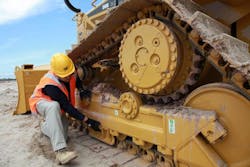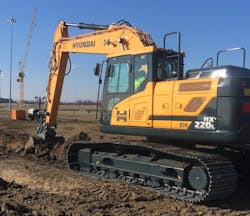Save Costs with Crawler Undercarriage Care
The crawler undercarriage, though it looks relatively simple and seamless in operation, takes a lot of components working together to perform its duties—how those components are maintained and operated makes the difference between smooth, longer-term operation or expensive, too-frequent repairs.
One caveat, of course, is the type of application. Running in rock and other abrasives is different than moving dirt. For the purposes of this article, maintenance advice is matched to more conventional operation unless noted. Crawler undercarriages are used on bulldozers, crawler excavators, cranes, and other machines where ground pressure is a concern.
“The undercarriage supports the total weight of the machine and is continuously subjected to rocks and other obstacles when in operation,” says Jared Haughton, Volvo Construction Equipment’s product sales manager for used equipment. “Many of its parts are exposed to constant wear and stress. It’s also the most expensive part of an excavator. By keeping the undercarriage in good condition, you can count on improved safety and efficiency from the machine.”
There are three basic types of chain/track systems, based largely on how the pins and bushings, components within them, are lubricated. The pins and bushings create the hinges in the track chain that allow the chain’s links to bend around the crawler’s sprockets and idlers.
The three types are the dry chain, the greased chain, and the sealed and lubricated track, or SALT.
“For the most part, the three are still pertinent today. Dry, and sealed and lubricated, are the most popular ones,” says Ron Miller, product specialist for Case Construction Equipment.
“The best maintenance tip on any of them would be to make sure you have the proper track size and the proper track tension be correlated, more so to the ground condition you’re working in,” Miller says. “In muddy-type conditions, you probably want a little looser track. That also plays into the fact that the operator needs to make sure that track is cleaned out periodically to try to keep that abrasive material away from those pins and bushings to keep from that extra wear that’s not needed.”
How to clean crawler undercarriage
Cleaning also aids in proper inspection.
“Clean the machine before an inspection,” Haughton says. “To do an inspection on the machine, it should be somewhat clean for the sake of accuracy. Although this may be time-consuming, cleaning the undercarriage regularly will keep it in a better condition, make it easier to see issues at an early stage, and lessen the wear on the components.”
Haughton recommends conducting a visual inspection once a week or every 40 operating hours, which means technicians and operators should be doing inspections in addition to any efforts undertaken by a dealer.
“Visual undercarriage inspections should not replace regularly scheduled undercarriage management,” Haughton says. “Proper undercarriage management entails measuring undercarriages, tracking wear, replacing worn components, and swapping component positions to extend the total undercarriage life. You’ll need conversion charts for each brand of undercarriages to convert them to percent worn.
“Measure the track tension and document the results. Make adjustments to the track tension if necessary and document the adjustments as well. You can find the correct track tension in the operator manual,” Haughton says.
Above: A clean track is an easier to inspect track.
“I can’t emphasize enough that proper track tension is critical. Also, a lot of customers don’t realize that when they’re doing proper track tension, they’ll go in and just tension it up, and actually the machines need to be moved to make sure the material is broken up and the dirt has broken away before they do track tension on it,” Miller says.
Miller stresses moving the machine beforehand.
“I like to move it two or three distances forward, back it up a couple of times, in a straight line, and that way you’ll have equal pressure on all of the tracks. Then adjust the track tension per the OEM specifications,” Miller says.
“Inspect the track’s components,” Haughton says. “When inspecting the machine, go through one side at a time. Keep in mind that the sprocket is at the rear of the machine and the idler is in the front, so the right and left side are not mixed up in the report. Remember to check track shoe, link, pins, bushings, top and bottom rollers, idlers, and sprockets.”
Check for undercarriage leaks
Also, look for component leaks.
“While you’re walking around, look for any leaking seals that might take place,” Miller says. “A lot of times, it’s a good practice to lift the machine to get the weight off of some of the lower rollers and components to see if any leaks would occur with weight off of them.”
“Also, check for rocks lodging down in the track itself, any materials that you’d need to clean up more often, and if you typically run in larger rock, make sure you have rock guards on the machine to prevent rocks from getting in the pins and bushings,” Miller says.
Temperatures can play a role in concert with difficult ground conditions.
“Another thing is geographical location and whether you typically have freezing temperatures,” Miller says. “If the operator runs the machine in heavy, packed conditions or muddy conditions, and it freezes at night, the undercarriage becomes frozen and can freeze to the ground. I always recommend not only to make sure it’s cleaned out, but also that it’s a good idea to start parking the machine on some kind of boards or some kind of material that would not freeze to the ground.
“Because what happens is the material freezes to those seals, and when you try to move the undercarriage, you damage those seals,” Miller says. “When you damage a seal, you’ve lost lubricity properties within the bushing, if it’s sealed and lubricated. If it’s a dry bushing, you just want to make sure it’s cleaned out periodically.”
Have the descriptions of specific components handy to help make an accurate assessment.
“Check the components according to the description for that specific component,” Haughton says. “Take notes and fill in any useful comment. Carefully check the links for cracks, spalling, side wear, and wear on the pin boss. You can also count the links to see if one was removed during assembly in an effort to tighten the undercarriage. If someone has made it too tight, that will spell trouble in the near future.”
The last step, according to Haughton, is a comparison of the undercarriage’s sides to check wear distribution.
“Compare the two sides of the undercarriage assembly to each other,” Haughton says. “Does one side show more wear than the other? Use the wear distribution graphic at the bottom of [a manufacturer’s] checklist to indicate the overall wear for each side. Should one side have more wear than the other, show this by marking that side further from the center, but still relative to the wear on the better side. If you’re unsure exactly what you’re looking at or what might need to be done, your local dealer can help.”
A number of factors can result in uneven wear, and this is where proper operation plays a part. One is high-speed operation.
“I always say, the faster you go, the faster it’s going to wear,” Miller says. “But some of the most unusual [wear] conditions come from operators that are generally dominant or one-sided, and that means they’re going to turn or push to one side of the dozer predominantly.
“When you do that, you start seeing unnatural wear to one side of the undercarriage because you’re constantly pushing to the opposing side; you’re trying to speed up the turn or doing more turns to one side, which will accelerate that movement and wear,” Miller says.
“I can tell by looking at undercarriage and inspecting it if the guy is dominantly a left- or right-hand person, because they’ll tend to veer to one side or the other,” Miller says.
He points out that looking for wear with the naked eye is far different than measuring the wear patterns.
“A lot of times you can physically see things, but a lot of times you’re wearing an unequal amount and you really can’t see it. There’s a need to truly measure to see what your wear actually is,” Miller says. “That’s where working with a good dealer makes a difference.”
Customers and dealers partner for undercarriage success
“With undercarriage, you can generally be proactive about it, you can watch to see what the lifecycle is on it, and you can kind of predict when a failure is going to occur for the most part,” Miller says.
“As you’re doing that, you can plan to have planned maintenance on it, such as pin and bushing turns, or replacements based off of keeping track of how your undercarriage is wearing. Doing it that way also gives the dealer an opportune time to have the components in place ready to do the repair or exchange.”
About the Author
Frank Raczon
Raczon’s writing career spans nearly 25 years, including magazine publishing and public relations work with some of the industry’s major equipment manufacturers. He has won numerous awards in his career, including nods from the Construction Writers Association, the Association of Equipment Manufacturers, and BtoB magazine. He is responsible for the magazine's Buying Files.


